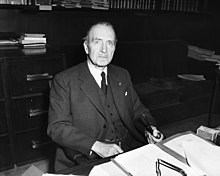Louis Charles Breguet
Louis Charles Breguet (born January 2, 1880 in Paris , † May 4, 1955 in Saint-Germain-en-Laye ) was a French aircraft designer and a co-founder of the airline Air France .
Life
Born in 1880, the grandson of the watchmaker and physicist Abraham Louis Breguet , the young Breguet took over the electrical engineering department of the family business in Douai as chief engineer in 1902, after successfully studying at the Supélec engineering school (then École Supérieure d'Électricité ) . Three years later he developed an advanced wind tunnel to analyze the air resistance of wings. He also improved the electric motors of the French submarines Mariotte and Archimède . At the Olympic Games in Paris in 1924, he took part in the sailing competitions in the 8-meter class and won a bronze medal.
Aviation Enthusiasm
As early as 1895, family friend Charles Richet was able to get Breguet enthusiastic about aviation. They began with the development of controlled, vertical takeoff aircraft with the 45–50 hp V8 Antoinette petrol engine . The performance of the engine was considered a breakthrough in aviation technology. Together with his brother Jacques and Charles Richet Breguet now began the construction of a gyroplane (also Gyroplane ) in 1907. The aircraft was launched on 24 August 1907, and was at a height of 50 cm off the ground. In October 1908, Louis Breguet and Richet founded an aviation construction company ( Société des ateliers d'aviation Breguet-Richet ) in which, among other things, flying machines, gyroscopes, airplanes and rotors were industrially manufactured.
He built his first aircraft, the "Breguet I" biplane , in 1907. During the famous Flugtage (French: meeting de Champagne ) in Reims , it took off despite bad weather and strong winds. After a flight of a few hundred meters, he crashed, but was uninjured. In September 1908 he built the improved Breguet II. He was able to achieve great success with this aircraft, including a flight of 40 km in 30 minutes from Douai to Arras on April 12, 1910. But this aircraft also gave him a few minutes of horror a fall from a height of 20 meters, which he survived with minor injuries.
Success as an aircraft manufacturer
In the same year he sold the first two aircraft to the French army. He was also awarded the Legion of Honor. In 1911 he set several speed records on distances of 10 km and 100 km with passengers.
Due to the success that his aircraft were able to achieve, Louis and his brother founded the Société anonyme d'aviation Louis Breguet , based in Douai, which quickly expanded its range of services. In order to promote the development of their aircraft, they recruited additional engineers, technicians and pilots. In 1912 the company built its first seaplane .
During the First World War , Breguet mainly supplied reconnaissance aircraft and the Breguet 14 attack aircraft to the French army. He was one of the first aircraft designers to build aircraft with an aluminum outer skin .
In 1919 he founded the air freight agency "Compagnie des Messageries Aériennes", which laid the foundation for the airline Air France and made numerous aircraft available for Aéropostale .
Its aircraft continued to set numerous records over the years. Among other things, a Breguet was the first non-stop aircraft to cross the South Atlantic in 1927 . Another flew over a distance of 7,250 km in another Atlantic crossing in 1930.
The helicopter pioneer
In 1935 he devoted himself again to the construction of rotary wing aircraft - together with René Dorand he developed the Gyroplane Laboratoire , the first stable flying helicopter . The aircraft had a coaxial rotor and reached a speed record of 108 km / h on December 22, 1935. Breguet was also able to demonstrate the combination of speed with good flight characteristics. In the following year, the "Gyroplane Laboratoire" set a height record of 158 m.
Even during the Second World War , Breguet remained an important aircraft designer and, after the war, also developed aircraft for civil use. He died in Paris in 1955.
family
The brother Jacques Breguet was also an aircraft designer and manufacturer. The Breguet Glacier in Grahamland , West Antarctica, is named in their honor.
literature
- Günter Schmitt, Werner Schwipps: Pioneers of early aviation , Gondrom Verlag, Bindlach 1995, ISBN 3-8112-1189-7 .
Web links
- Louis Charles Breguet in the Sports-Reference database (English; archived from the original )
Individual evidence
- ↑ The great book of aviation and space travel. Südwest Verlag, Munich 1973, ISBN 3-517-00420-0 (p. 143)
| personal data | |
|---|---|
| SURNAME | Breguet, Louis Charles |
| BRIEF DESCRIPTION | French aircraft designer |
| DATE OF BIRTH | January 2, 1880 |
| PLACE OF BIRTH | Paris |
| DATE OF DEATH | May 4th 1955 |
| Place of death | Saint-Germain-en-Laye |



